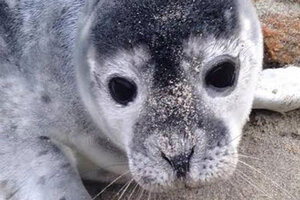Please skip the seal selfies, for pups' sake, asks NOAA
The National Oceanic and Atmospheric Administration released a statement warning people of the dangers of taking photos with wild animals in an attempt to avoid injury to people or seal pups as the seal birthing season gets underway.

Prompted by an increased desire for selfies taken with wildlife, the National Oceanic and Atmospheric Administration cautions seal-watchers to keep their distance from seal pups as mothers may abandon their pups if you get too close.
Courtesy of Marine Mammals of Maine
Wildlife officials are urging seal admirers to keep their distance from the new pups, as tourists become bolder in their quests for the perfect selfie.
An ill timed snapshot with a seal pup could be disastrous for the young animal and the selfie-seeker, the National Oceanic and Atmospheric Administration warns.
The warning comes after a string of impromptu selfie-sessions have left a range of animals, from dolphins to bison to sharks to people, injured or dead.
“There’s this general phenomenon where we raise the bar for ourselves of what would be a fun selfie to take and share with others,” associate professor of psychology Zlatan Krizan, Iowa State University, told LiveScience in July 2015 after a woman was injured while taking a selfie with a bison. “Nobody wants to be outdone.”
Last summer, a woman and her daughter were traversing Yellowstone National Park when they began taking selfies about 6 yards away from a group of bison. After hearing bison footsteps nearing they began to run, but a bison caught and gouged the mother.
The mother was at least the fifth person to be injured in a bison attack in last year.
The trend of taking seflies with wildlife can also be dangerous for animals, wildlife advocates and officials say. That concern became a tragic reality for a baby dolphin this past winter.
In February group of beachgoers in Argentina pulled a baby Franciscana dolphin from the water and passed it around to pet and take photos. The group eventually left the young dolphin on the sand after it stopped moving and appeared dead – prompting outrage from conservation groups.
“Wild animals are not toys or photo props. They should be appreciated – and left alone – in the wild where they belong,” a spokeswoman for World Animal Protection told the Australian Broadcasting Corporation after the event.
A week later, a man in Palm Beach, Fla., dragged a shark from the ocean and pinned it in the sand for a quick photo-op. Later, another man dragged the shark back into the water to release it. The man and the shark appeared unharmed by the encounter, but video of the stunt was widely criticized.
NOAA is hoping to prevent similar situations with recently born seal pups that may have been left on the beach to rest while their mothers hunt and feed.
“Getting too close to a wild animal puts you – and the animal – at risk,” The NOAA warned. “It is normal for a mother seal to leave her young pup alone on the beach for up to 24 hours while she feeds.”
The risk to seal pups can be even more severe than other animals. Seal pups can be naturally curious, according to the NOAA, and may approach people that wander too close on their own. And while it may take only a moment to snap a photo, the mother may be watching from the ocean and decide the risk is too great to come back and abandon her pup.
Likewise, NOAA reminded potential photo takers that seals do have a powerful bite that could cause damage and the act of approaching a wild animal could be considered illegal harassment.
To avoid risk to the seal pups and people, NOAA recommends staying at least 50 yards (150 feet) away from any seals.
“The best thing you can do if you want to help is keep away from the animal and keep your pets away from it, so the mother has a chance to return,” Mendy Garron, marine mammal stranding program coordinator for NOAA Fisheries Greater Atlantic Region, said in a statement.

